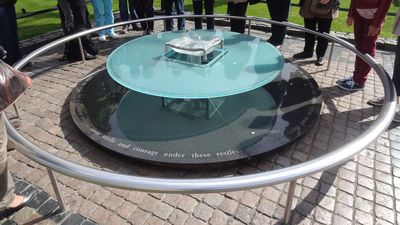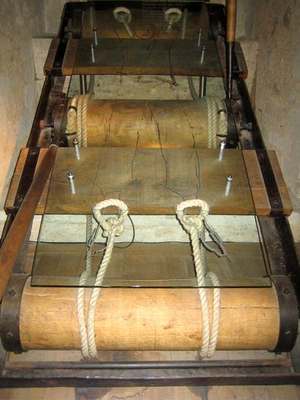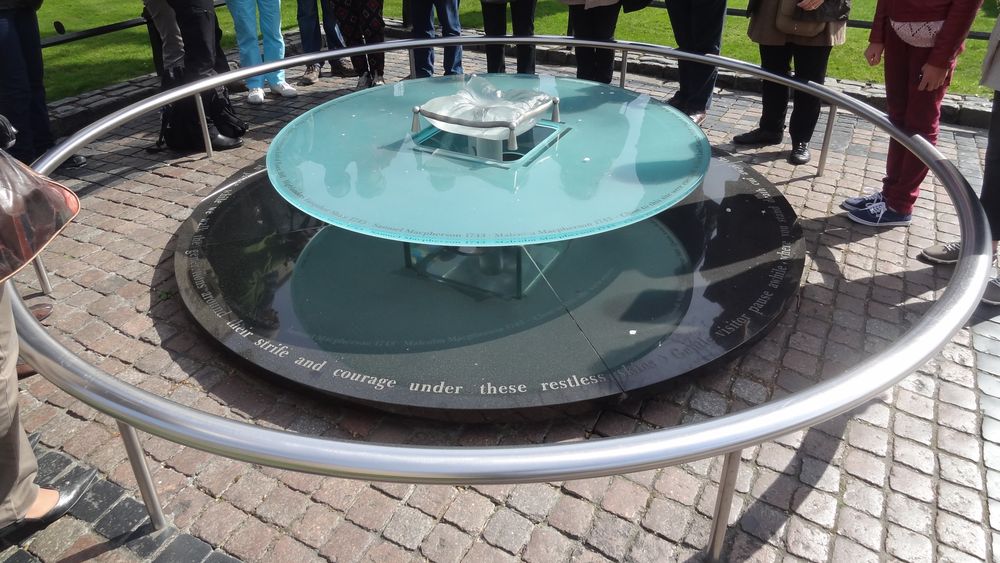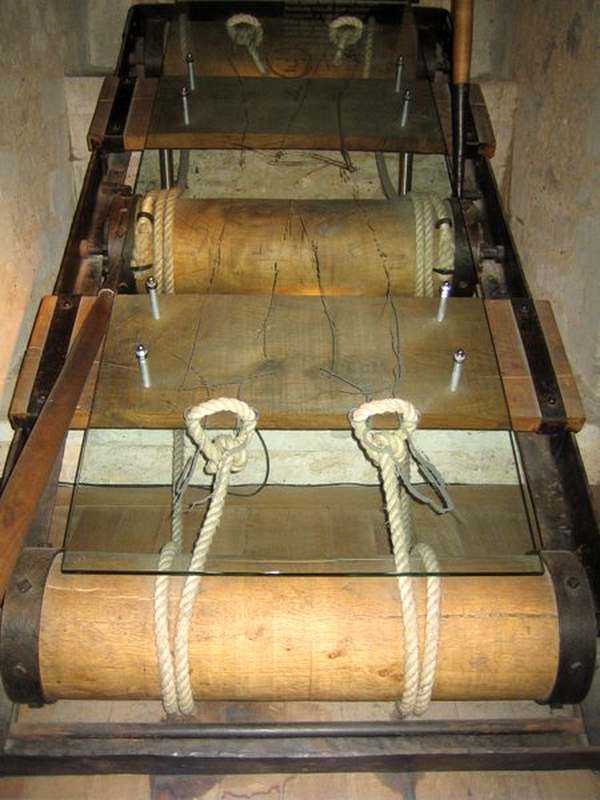The Tower of London is much admired for its architecture and history, but its name also evokes fear, imprisonment, torture. Yet deserves so much to have that reputation?

Memorial to the executed of the tower
A Fact: The Tower of London served as a prison
It is undeniable that the Tower of London sheltered prisons. In fact most of the towers shelter cells in their basements, and they were not decorative: they really kept away from personalities. But in reality, not so much. The prisoners of the Tower of London were essentially important personalities, queens and kings, opponents, etc. There were also members of the clergy or aristocrats who had chosen the wrong camps during the war between the two roses, but also officers, Scottish rebels and even a king of France! The very first prisoner was imprisoned in 1100, shortly after the completion of the construction of the white tower. But it was not a great success. With the help of external complicities, he was able to make himself beautiful by using a rope hidden in a barrel.
The condition of the prisoners varied greatly. Some had heavy sentences, others were lighter. Some even had the right to leave their cells, even to go out to walk in the whole citadel. William Penn, founder of the American colony of Pennsylvania, has endured eight months in prison for his religious beliefs. Duke Charles of Orleans, the nephew of the King of France, had been made prisoner in a battle, and had spent twenty-five years of his life in the care of the English until an exorbitant ransom was paid. Similarly, the courtier, explorer and writer Sir Walter Raleigh has endured thirteen long years of prison, years in which he wrote his universal history, entitled History of the World. He was then temporarily released to be executed shortly afterwards. The heir of Henry VIII, his son Edward VI (also Anglican), continued after his coronation to make brutal purges. Six years later, he died and was replaced by Marie Tudor (a fervent Catholic, unlike Henry VIII, his father). She did not hesitate to have Lady Jane Gray - 16 years - and her young husband, pawns in the fight for power, beheaded without delay. Isabelle, the sister of Marie's father, spent several weeks in prison in the tower before being able to leave.
Some famous performances
But although there were quite a few prisoners, there were only a few executions in view of the history of the Tower of London: just over 400 people were killed here, near 1000 years of history. In fact, the place of execution was at Tower Hill, a place a little further north that allowed control of the crowd.
The Tower of London was the seat of several murders. Among the best known are the mysterious deaths of the two little Princes, Edward V and his younger brother Richard, Duke of York. There was also the tragic story of the execution of Lady Jane Gray, Queen of England, as well as the other queens Catherine Howard and Anne Boleyn. King Henry VI of England died murdered during his prayer in the private chapel of the Wakefield Tower.
Once dead, the bodies were - most of the time - buried in the royal chapel of St. Peter. There were even people who were executed outside. Here is a small list of the main dead personalities executed at the Tower of London on Tower Green:
- William Hastings, Baron d'Hasting (June 13, 1483). Performed by decapitation, William Hastings struggled to secure the throne of Edward IV by supporting his sons, the two Little Princes.
- Anne Boleyn, queen consort (May 19, 1536). Executed by decapitation, she was the second wife of King Henry VIII and was wrongly convicted of adultery, incest and treason.
- Margaret Pole, Countess of Salisbury (27 May 1541). Executed by decapitation. The Countess of Salisbury was accused of treason at the age of 68 by King Henry VIII. He reproached him for having supported his first wife Catherine of Aragon, fervent Catholic.
- Jane Boleyn, Viscountess of Rochford (1542). Executed by decapitation. Jane Rochford helped provoke the murder of the two queens and their cousins, Anne Boleyn and Catherine Howard.
- Catherine Howard, queen consort (13 February 1542). Performed by the decapitation, Catherine Howard was a crazy and disinterested girl who was killed for adultery at the age of 18 only.
- Jane Gray, Queen (February 13, 1554). Executed by the decapitation, Lady Jane Gray was a queen manipulated by her family, particularly ambitious. She suffers the consequences in their places.
- Robert Devereux, Earl of Essex (1601). Executed by the decapitation, the Earl of Essex was the favorite of Queen Elizabeth I, but he rebelled against her and was imprisoned, then executed.
According to legend, you can see Anne Boleyn, executed for treason to King Henry VIII, walk around the Tower with her head under her arm. To learn more about each of these people and more, see the list below.
Methods of execution
The most common method of executing a person was decapitation, but it concerned only prisoners of a certain status as it was considered to be less brutal than the other methods. It was, therefore, reserved for nobles and members of the royal family. A hatchet was used almost systematically, but sometimes, on very rare occasions, a sword was used. This was the case, for example, when Anne Boleyn died.
People of lower rank, the current of the population, was killed by hanging. But if the alleged offenses were particularly odious, it was possible to use more brutal methods, such as the woodcutting or the scuttling. It sometimes even happened to put up long suffering voluntarily, and that whatever the social class of the victim, but it was still some rare things.
Death by decapitation was mainly used for nobles. It was a violent but short-lived method, fortunately. But it was common for the executioner to resume several times to detach the head from the trunk of the condemned man. It depended on his skill and the state of his blade. The sharper it was, the quicker the execution. Thus death was quick and painless. Otherwise, as was the case with the Countess of Salisbury, it was probably much more painful: She suffered 11 blows before death occurred.
Traditional ceremonies during decapitation
It is not that a tradition is particularly joyful, but during a performance a certain protocol was respected. First of all, a scaffold was built, a kind of platform that was covered with straw. A member of the clergy was in charge of comforting the condemned as much as he could, but above all he encouraged him to forgive his executioner, which allowed him to have his favors and thus get a quick word .
Most of the time the condemned man was authorized to address the crowd, with the king's permission. Then, once the sentence was executed, the heads of the victims were exposed on the London bridge. Note that during a decapitation the head retains a consciousness for approximately 8 seconds, it is the time necessary for the lack of oxygen in the blood causes the fall in the unconsciousness.
The main executed
William Hastings
Executed by decapitation on 13 June 1483
William Hastings fought to secure the throne for Edward IV. He was appointed Lord Chamberlain in 1461. When King Edward died in 1483, he was a faithful and loyal supporter of Edward V's young son, Edward V, known to be one of the little princes of the Tower. He was arrested by Edward's brother, Richard, under the title of treason. The two little princes were declared illegitimate, and their uncle and protector, Richard, Duke of Gloucester, was declared king and crowned under the name of Richard III. The two little princes were never seen again. William Hastings was executed without trial.
Anne Boleyn
Executed by decapitation on May 19, 1536
Anne Boleyn, Queen of England (1507-1536) was the second wife of King Henry VIII. The latter divorced from his first wife, Catherine of Aragon, and broke with the Catholic Church. As a result, he was excommunicated out of love for this woman. Afterwards he grew tired of his wife and fell in love with Jane Seymour. As a result, he arrested Anne Boleyn under the charge of treason, adultery and incest with her brother George Boleyn, Lord Rochford. Anne Boleyn entered the Tower of London through the Traitors' gate where she was greeted by William Kingston, the guardian of the tower. She asked if she should be taken to a dungeon but was assured that she would be imprisoned in the royal apartments where she had spent her time before her coronation. Death by the ax was a terrifying prospect. The executioners often recovered several times before the head was finally cut off. This is what happened to Anne who was given the opportunity to be beheaded with a sword. When she spoke of her execution she referred to the comforting fact that she "only had a small neck".
Margaret Pole, Countess of Salisbury
Executed by decapitation on 27 May 1541
Margaret Pole, Countess of Salisbury (1473-1541) was the last direct descendant of the Plantagenet line, descended from King Edward III. The countess made the mistake of appearing with Catherine of Aragon against the king who declared him a traitor. She was arrested two years before her execution, ill-treated and neglected during her detention. She has never been tried. She was small, frail and sick, but proud. So, on the day of her execution, she had to be dragged to the block. on the spot she refused to lay her head on it and struggled with all her strength. The inexperienced executioner fractured his shoulder rather than his neck. She jumped from the log and the executioner had to pursue her with her ax in her hand. She was struck eleven times that the head was not detached. There were 150 witnesses of his execution that day. Margaret Pole was 68 years old.
Catherine Howard
Executed by decapitation on 13 February 1542
Catherine Howard was the fifth wife of King Henry VIII, the cousin of Anne Boleyn. Particularly pretty, Henry was at her painstaking care, covering her with gifts and making a public display of great love. She had led a permissive life in the household of her grandmother, the Dowager Dowager of Norfolk, an uneducated and neglected woman. After her marriage to Henry VIII, who was a disgusting and obese old man, she had an affair with the handsome young Thomas Culpepper, a bond that was discovered. King Henry was devastated. Catherine was arrested at Hampton Court for adultery and tried in vain to rejoin the king. She was shrieked in her apartments. Her lover was executed, her head still buried in a pike when she too passed under the London Bridge before entering the Tower of London by the door of the traitors. The legend says that Catherine's last words were: "I die as queen, but I would rather die as a Culpepper's wife." She was then only 18 years old.
Jane Boleyn, Viscountess of Rochford
Executed by decapitation on 13 February 1542
Jane Boleyn, Viscountess Rochford (1505-1542) was the wife of George Boleyn, the brother of Queen Anne Boleyn, who was executed on her incest with her sister. Jane Rochford was a wicked and jealous woman. Her husband George Boleyn was elderly and unhappy. Ella played a decisive role in the arrest of her sister-in-law, Anne and her husband George Boleyn, proving damaging evidence against Thomas Cromwell. His allegations were completely false, but were detained against Anne. She became a Private House Lady to Catherine Howard. During her lifetime Jane Rochford was intrigued and encouraged the young queen to maintain her relationship with Thomas Culpepper, she had helped organize secret meetings. However, her responsibility was discovered and Jane Rochford was arrested and taken to the Tower of London. She was interrogated and lost her mental health. A new law allowing the execution of madmen was adopted on this occasion to condemn her to death. She confessed before her death: "God makes me undergo shame as a punishment for having contributed to the death of my husband, and I falsely accused him of loving incestuously his sister, Queen Anne Boleyn. to die".
It was executed immediately after Catherine Howard.
Lady Jane Grey
Executed by decapitation on 12 February 1554
Lady Jane Gray, Queen of England (1537-1554) was Queen of England for only nine days, from Monday, July 10, 1553 to Wednesday, July 19, 1553. Edward V, a devout Protestant and the only son of Henry VIII, of tuberculosis and left the throne to "Lady Jane and his male heirs". Unfortunately for her, she was a puppet in the hands of her parents, the powerful Dudley family. She was proclaimed Queen of England and brought with her husband Guildford Dudley of Syon House to the Royal Apartments at the Tower of London. On July 19, 1553, Queen Jane was deposed, raising no objection - Catholic Princess Mary being the legitimate heir. Lady Jane Gray and her husband were imprisoned in the Tower. On February 12, 1554, they were executed at the Tower of London. Lady Jane watched as her husband moved from the Beauchamp Tower to her death at Tower Hill a few hours before her own execution on Tower Green. Jane's death warrant was signed by Queen Mary who will later be known as "Bloody Mary" for her persecution of the Protestants. Lady Jane Gray was only 17 years old at the time of her death.
Robert Devereux, 2nd Earl of Essex
Executed by decapitation on 25 February 1601
Robert Devereux (1566-1601) was a favorite of Queen Elizabeth I. He was handsome, witty, arrogant and ambitious, and the Queen was full of praise for this man. He was appointed Lord Lieutenant of Ireland, a position which he could not secure. His relationship with the Queen deteriorated little by little and he tried a political coup. He led a rebellion against the Queen and wanted to take control of the city of London on February 8, 1601. He was arrested and sentenced for treason. Dressed in black, but with a shiny red waistcoat, Essex was executed at the Tower of London on February 25, 1601. More than 100 people attended the execution, and three blows of the ax were necessary to blow up the head of Essex.
The main prisoners
Of course not all the prisoners were executed. Some were released, others died in their cells. The list below does not contain all the names but gives an idea of the quality of these people.
- The bishop Ranulf Flambard (the first prisoner of the Tower of London)
- Hubert of Burgh, Chief Justice of England (1232)
- William of Marish (1238)
- Prince Gruffydd of Galles (died falling from a height of 30m while trying to escape), 1244)
- King Baliol of Scotland (1296)
- William Wallace (1305)
- Lady Badlesmere, Margaret of Clare (First woman prisoner, 1322)
- Charles, Duke of Orleans (1391-1465)
- Eleanor, Duchess of Gloucester (1441)
- The king Henry VI (1465)
- Duke of Clarence (1478)
- William Hastings (1483)
- Jane Shore (1483)
- The two princes Edward V and Richard, Duke York (1483)
- John Fisher bishop of Rochester (1534)
- Sir Thomas More (1535)
- The involved with Anne Boleyn (Mark Smeaton, Henry Norris, Frances Weston, William Brereton and George Boleyn, 1536)
- Sir William de la Pole incarcerated in the tower during 37 years
- Thomas Cromwell (1540)
- The involved with Catherine Howard (Anne Howard, Thomas Culpepper, Henry Mannox and Francis Dereham, 1542)
- La protestante Anne Askew (Tortured, 1545)
- Henry Howard, County of Surrey (1546)
- Thomas, Duke of Norfolk (1546)
- Princess Elizabeth and her servants Kat Ashley and Henry Parry (1554)
- Thomas Seymour, High Admiral of England (1549)
- Duchess of Somerset (1551)
- Edward Seymour, Duke of Somerset and Lord Protector (1552)
- Guildford Dudley, husband of Lady Jane Grey (1554)
- Hugh Draper of Bristol (Witchcraft, 1561)
- John Store (1571)
- Guy Fawkes (1606)
- Nicholas Owen (Jésuite, 1606)
- Thomas Overbury (1613)
- Sir Walter Raleigh (1618)
- Thomas Wentworth, County of Strafford (1641)
- William Laud, Archbishop of Canterbury (1645)
- James Scott, Duke of Monmouth (1685)
- Henry Laurens (only the first american prisoner, 1780)
- Sir Francis Burdett
- Les Conspirators Cato-street
- Roger Casement
- Norman Baillie-Stewart (1933-1937)
- Josef Jakobs
- Rudolf Hess (1945)
- The twins Kray (1952)
Torture, widely overestimated

Easel
Torture, on the other hand, has hardly ever been used in the Tower of London. This place was not a place of torture as is often believed. In fact, its reputation probably stems from the need to make the London Tower fear the population, which was its original function, a function it has kept throughout its history. If nowadays we can see torture instruments in the Tower of London showrooms at Wakefield Tower, it is that they were added later, mainly for tourists.
The torture records in the Tower of London refer to 48 people, all of whom were tortured here between 1540 and 1640. This figure seems low, but even if it is underestimated, it still shows that this was not the place of ultimate torture that is believed to be sometimes.
The instrument of torture which is reproduced above is a sort of easel: The feet of the tortured were attached to the two strings at the bottom, the wrists to the two strings from above, and the two levers were actuated, the rollers turning the body disintegrated little by little.
See also:






















